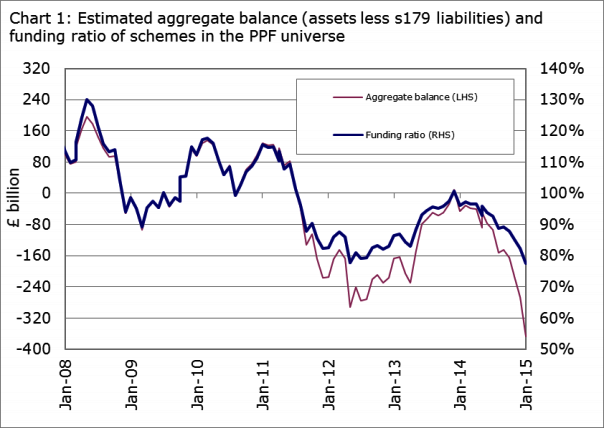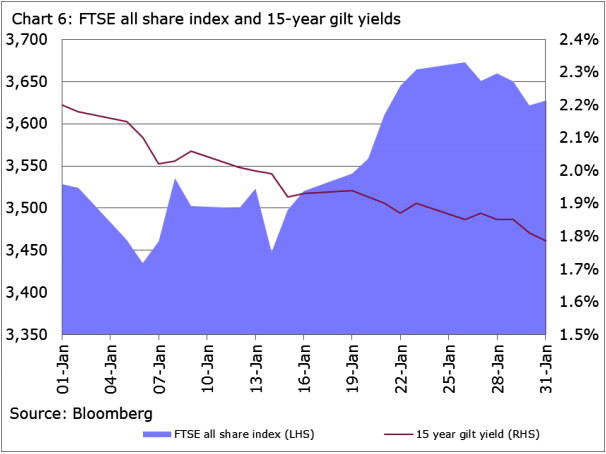A perfect storm of underperforming domestic equities and ever-falling gilt yields have pulled UK corporate pensions to their worse ever collective funding status, data has shown.
 (Source: Pension Protection Fund)Figures from the Pension Protection Fund (PPF), the lifeboat
for bankrupt company defined benefit plans, showed the aggregate deficit in
the UK had hit £367.5 billion at the end of January.
(Source: Pension Protection Fund)Figures from the Pension Protection Fund (PPF), the lifeboat
for bankrupt company defined benefit plans, showed the aggregate deficit in
the UK had hit £367.5 billion at the end of January.
Just a month earlier, this number had been more than £101 billion healthier at £266.3 billion.
The latest figure is a record aggregate deficit of the PPF 7800 index, which tracks 6,057 schemes. A year earlier, at the end of January 2014, this aggregate deficit was £46.4 billion. Previously, the greatest deficit was recorded at the end of July 2012 at £291.7 billion.
The PPF’s number combines figures from pensions both in surplus and with a shortfall. Today’s figures showed the number of funds able to meet at least 100% of their obligations—882—had fallen to its lowest ever level, with the amount they boasted in excess of liabilities the second lowest since the PPF started collecting data. Some 5,175 funds were reported as being in deficit, using the PPF’s measures.
In contrast to such dismal reading, combined assets in all schemes have never been higher at £1.27 trillion. However, neither have liabilities—at £1.64 trillion—and these have ticked higher with much greater speed.
 (Source: Pension Protection Fund)“Over the month of January 2015, liabilities rose by 9.2%,
reflecting decreases in nominal and index-linked gilt yields,” the PPF’s report
said. “15-year gilt yields fell by 41 basis points and 15 year
index-linked gilt yields fell by 22 basis points. Meanwhile, assets rose by 3%,
reflecting a 2.5% increase in equities, together with rising bond prices.”
(Source: Pension Protection Fund)“Over the month of January 2015, liabilities rose by 9.2%,
reflecting decreases in nominal and index-linked gilt yields,” the PPF’s report
said. “15-year gilt yields fell by 41 basis points and 15 year
index-linked gilt yields fell by 22 basis points. Meanwhile, assets rose by 3%,
reflecting a 2.5% increase in equities, together with rising bond prices.”
Over the year to January 2015, 15-year gilt yields were down by 138 basis points and the FTSE All-Share index was up by 3.6%.
Arno Kitts, head of UK institutional at BlackRock, noted that since the inception of the index in 2003, liabilities have grown at an average of 10% annually, outstripping asset growth of 7%. “Critically, the liabilities have also dominated in driving the volatility in funding levels, with liability volatility of 15%, compared to 5% for assets,” he added. “This emphasises the importance of managing liability risk effectively.”
In December, a report by Fathom and Pension Corporation—titled “Who carries the risk?”— claimed lower government bond yields could force UK sponsors to pay out more than £10 billion a year between 2016 and 2025 to plug funding gaps in the pension funds, and more than £20 billion between 2018 and 2023.
Related Content:US Public Pension Shortfall Triples in Under a Decade & How Could the PPF Fail?
